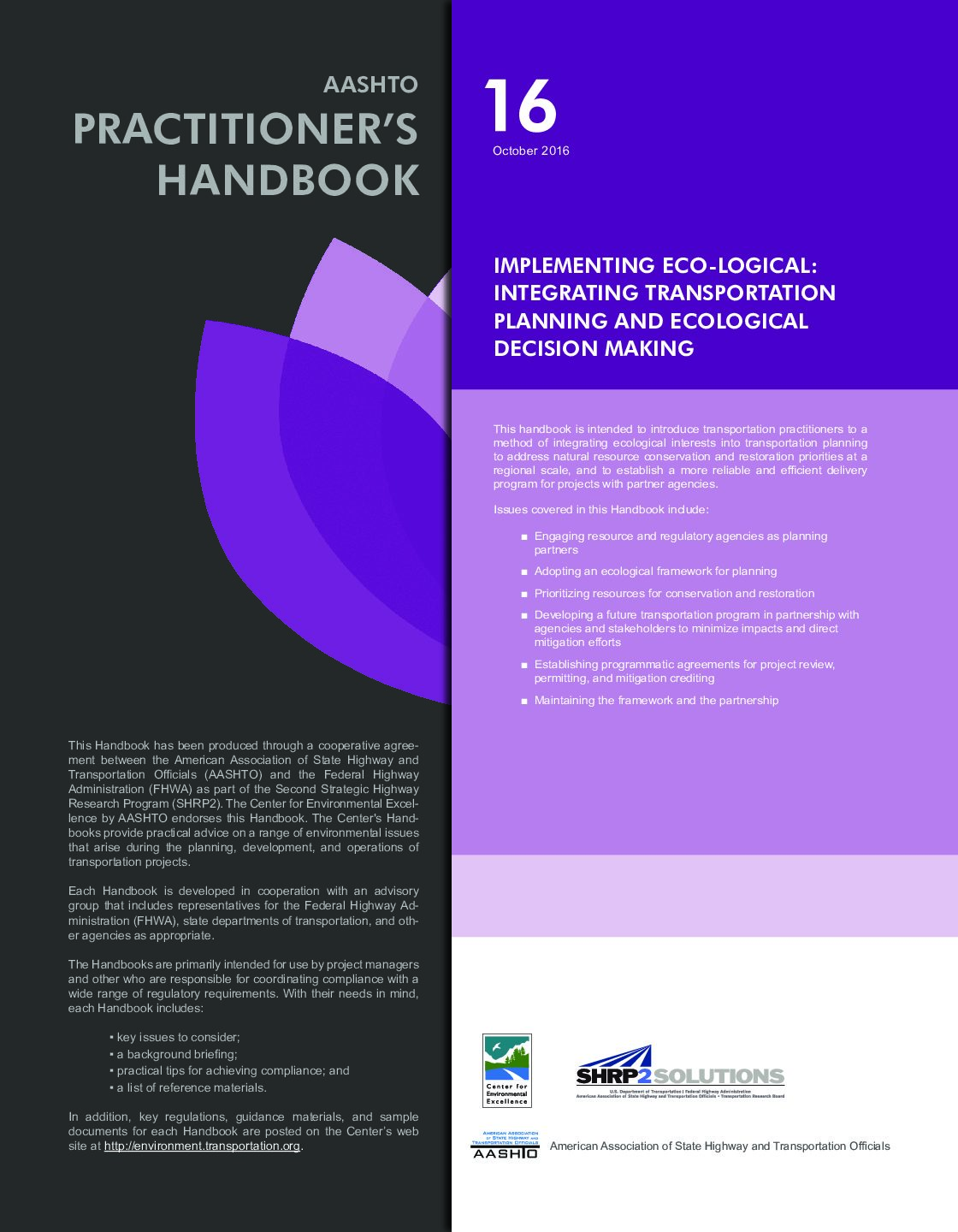Handbook Resources
American Association of State Highway and Transportation Officials (AASHTO). 2008. Practitioner’s Handbook 10: Using the Transportation Planning Process to Support the NEPA Process. Center for Environmental Excellence by AASHTO, Washington, DC.
View Handbook
Brown, Janice W. 2006. Eco-Logical: An Ecosystem Approach to Developing Infrastructure Projects. FHWA-HEP-06-011. Federal Highway Administration, Washington, D.C.
https://www.environment.fhwa.dot.gov/ecological/eco_index.asp
Drechsler, M. and F. Watzold. 2009. “Applying tradable permits to biodiversity conservation: Effects of space-dependent conservation benefits and cost heterogeneity on habitat allocation.” Ecological Economics. 68(4): 1083-1092.
https://www.researchgate.net/publication/23991071_Applying_Tradable_Pe
rmits_to_Biodiversity_Conservation_Effects_of_Space Dependent_Conserva
tion_Benefits_and_Cost_Heterogeneity_on_Habitat_Allocation
Department of the Army, Corps of Engineers and the U.S. Environmental Protection Agency. 2008. “Compensatory Mitigation for Losses of Aquatic Resources.” Federal Register, Vol. 73, No. 70, Thursday, April 10, 2008.
http://www.ecy.wa.gov/programs/sea/wetlands/mitigation/banking/pdf/Fin
al_mitigation_rule_4_10_08.pdf
Executive Order 13274. “Environmental Stewardship and Transportation Infrastructure Project Reviews.” September 18, 2002. Federal Register, Vol. 67, No. 184. September 23, 2002.
https://www.gpo.gov/fdsys/pkg/FR-2002-09-23/pdf/02-24252.pdf
Executive Order 13604. “Improving Performance of Federal Permitting and Review of Infrastructure Projects.” March 22, 2012. Federal Register, Vol. 77, No. 60. March 28, 2012.
https://www.gpo.gov/fdsys/pkg/FR-2012-03-28/pdf/2012-7636.pdf
Federal Highway Administration. 2011. FHWA Scenario Planning Guidebook. Research and Innovative Technology Administration, U.S. Department of Transportation, Washington, DC.
https://www.fhwa.dot.gov/planning/scenario_and_visualization/scenario_
planning/scenario_planning_guidebook/
Federal Highway Administration and Federal Transit Administration. 2005. Linking the Transportation Planning and National Environmental Policy Act (NEPA) Processes. Washington, DC.
http://www.fhwa.dot.gov/hep/plannepa050222.pdf
Institute for Natural Resources, NatureServe, Parametrix, Inc., and CH2M HILL. 2012. An Ecological Approach to Integrating Conservation and Highway Planning, Volume 2. SHRP2 Report S2-C06-RW-2. Transportation Research Board, Washington, D.C.
http://www.trb.org/Main/Blurbs/166938.aspx
Murcia, C. 1995. “Edge effects in fragmented forests: implications for conservation.” Trends in Ecology and Evolution. 10(2): 58-62.
https://www.researchgate.net/publication/49757343_Edge_Effects_in_Frag
mented_Forests_Implications_for_Conservation
Schwartz, M.W. 1999. “Choosing the appropriate scale of reserves for conservation.” Annual Review of Ecology and Systematics. 30:83-108.
https://www.researchgate.net/publication/223995601_Choosing_the_Approp
riate_Scale_of_Reserves_for_Conservation
Crist, S. Howie, M. Venner, J. Kagan, and L. Gaines. 2014. Manager’s Guide to the Integrated Ecological Framework. SHRP2 Report S2-C06-RW-4. Transportation Research Board, Washington, D.C.
http://onlinepubs.trb.org/onlinepubs/shrp2/SHRP2_S2-C06-RW-4.pdf
U.S. Environmental Protection Agency. 2008. Handbook for Developing Watershed Plans to Restore and Protect Our Waters. EPA 841-B-08-002, March 2008.
https://www.epa.gov/polluted-runoff-nonpoint-source-pollution/handbook
-developing-watershed-plans-restore-and-protect

